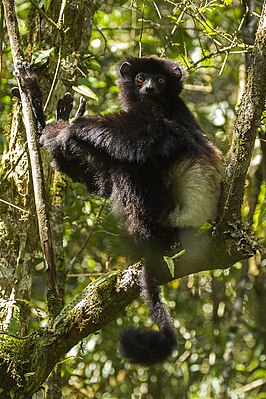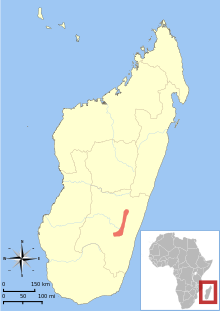Edwards Sifaka
| Edwards Sifaka | ||||||||||||
|---|---|---|---|---|---|---|---|---|---|---|---|---|

Edwards sifaka ( Propithecus edwardsi ) |
||||||||||||
| Systematics | ||||||||||||
|
||||||||||||
| Scientific name | ||||||||||||
| Propithecus edwardsi | ||||||||||||
| A. Grandidier , 1871 |

The Edwards-Sifaka ( Propithecus edwardsi ) is a primate from the family of the Indri-like within the lemurs . It is named in honor of Henri Milne Edwards . It was formerly considered a subspecies of the Diademed Sifaka .
features
Edwards sifakas reach a head body length of 42 to 52 centimeters, the tail is with 41 to 48 centimeters almost as long as the body. Their weight is 5 to 6.5 kilograms, making them one of the largest types of Sifakas . Their fur is predominantly black or dark brown in color, on the back of the back and the flanks there is a whitish, saddle-like markings, which are separated by a black stripe in the middle of the back. The face is also black but hairless, the eyes are orange-red.
distribution and habitat
Like all lemurs, Edwards sifakas are only found in Madagascar . They are widespread in the rainforests in the east of the island, their range extends from the Mangoro and Onive rivers in the north to the Andringitra mountains in the south. They occur up to 1700 meters above sea level.
Lifestyle and diet
These primates are diurnal tree dwellers. At night they sleep on forks, around 8 to 10 meters above the ground. During the day they go in search of food, where they move vertically climbing and jumping. They live in groups of three to nine animals, which consist of several males and females and the common young animals. The groups are led by the females and their composition is stable over several years. The groups inhabit a fixed territory of 45 to 55 hectares, which is marked with glandular secretions.
Edwards sifakas are herbivores that feed on leaves, fruits, seeds, and flowers. Sometimes they come to the ground to eat soil. This can serve to absorb trace elements or to neutralize toxins contained in the food.
Reproduction
After a gestation period of around 180 days, the female gives birth to a single young in June or July. This weighs around 150 grams at birth and initially clings to the mother's stomach, later it rides on her back. They are weaned after about six months and sexually mature after four to five years. The males then have to leave their birth group, the females also leave or stay in it.
Danger
The main threat to the Edwards sifakas is the destruction of their habitat from slash and burn, deforestation and mining and hunting. The IUCN estimates that in the last 30 years (three generations) has decreased the total population by more than 50%, and lists the species as "critically endangered" ( endangered ).
literature
- Nick Garbutt: Mammals of Madagascar. A Complete Guide. Yale University Press, New Haven CT 2007, ISBN 978-0-300-12550-4 .
- Thomas Geissmann : Comparative Primatology. Springer-Verlag, Berlin a. a. 2002, ISBN 3-540-43645-6 .
- Russell A. Mittermeier , Jörg U. Ganzhorn, William R. Konstant, Kenneth Glander, Ian Tattersall , Colin P. Groves , Anthony B. Rylands, Andreas Hapke, Jonah Ratsimbazafy, Mireya I. Mayor, Edward Louis jr, Yves Rumpler, Christoph Schwitzer, Rodin Rasoloarison: Lemur Diversity in Madagascar. In: International Journal of Primatology. 29, 2008, ISSN 0164-0291 , pp. 1607-1656.
Web links
- Propithecus edwardsi onthe IUCN Red List of Threatened Species . Retrieved April 23, 2009.



